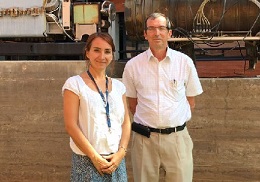
Investigators from the Universitat de València, CIBERNED, The University of California and the Institute of Investigation from La Fe have identified a massive population of young neurons, previously unknown, which migrate in the human brain during the first months of life contributing to the expansion of the frontal lobe, a region which is closely related to the cognitive and executive functions. Errors in these migrations could be the cause for some neurological disorders. The work has been published in ‘Science’.
Investigators from the Cavanilles Institute of Biodiversity and Evolutionary Biology of the Universitat de València, CIBERNED (Centre of Networked Biomedical Investigation into Neurodegenerative Diseases), the University of California and the Institute of Investigation from La Fe have presented the existence of a massive migration of new neurons, which, going from the ventricle walls of the brain, invade the prefrontal cortex, an area that is related to the cognitive and executive functions.
This neurogenesis occurs when the brain starts to interact with the environment that surrounds the child, which results in a faster growth of the brain’s size and the complexity of this region. The new neurons organise themselves in long chains that migrate long distances. Firstly, they travel in a tangential and parallel way to the surface of the lateral ventricles –many times associated to blood vessels which guide them– then, they radially spread as they move away from the ventricles, and, finally, they invade the prefrontal cortex in all directions.
The existence of this extensive migration of new neurons in the human brain during the breastfed stage appears after a series of previous works coordinated by the Mexican neurobiologist Arturo Álvarez Buylla (University of California, San Francisco). The existence of stem cells in the human brain had already been demonstrated in some studies which had jointly been done by the groups of Valencia and San Francisco (Sanai et al., Nature 2004). In addition, the group identified two migration routes of cells in the brain of the breastfed babies, which went from the ventral region of the ganglionic eminences to the olfactory bulbs and the ventral prefrontal cortex (Sanai et al. Nature 2011).
The migrations described on this occasion are initially organised in big chains of thousands of cells, whose concentration enables them to go through the complex nervous network which starts to develop in the more ventral areas –where the cells associated to the ventricle appear– until arriving at the top layers where they disperse and the differentiation starts. ‘These cells, which differentiate in inhibitory neurons, will be responsible of the information’s modulation by compensating the effect of the exciting neurons, balancing the activity of the human brain and contributing to the plasticity of its circuits. It is precisely here where an error could result in neurological disorders’, explains José Manuel García Verdugo, scientist in the project of the Cavanilles Institute from the Universitat de València.
As described in the article published in ‘Science’, in order to follow these migration paths the authors observed that the cells expressed molecular markers which characterised the immature migratory cells. Furthermore, after the analysis of their ultrastructure with electron microscopy, they identified characteristics which indicated cellular movement, such as their fusiform morphology or the presence of occasional dense contacts. Scientists managed to see the real movement of these migratory cells ‘in vivo’. In order to do so, they used slices of post-mortem tissue obtained a few hours before the death, in which they marked with fluorescence the migratory cells and they saw how they moved in chains and even how some of them individually separated themselves until arriving at their final destination.
These migrations mainly occur during the first three months of life but they persist until approximately the first seven months. From two years on, the quantity of these migrations is limited. From six years on, they are not detected anymore. For this reason, given the dynamic nature of the frontal lobe in the breastfed stages, brain damages during the neonatal period and the first three months could affect the neuronal recruitment in the prefrontal cortex, leading to certain neurocognitive and sensorimotor deficits such as epilepsy, cerebral palsy and disorders of the autism spectrum.
------------------------
Extensive Migration of Young Neurons into the Infant Human Frontal Lobe . Authors: Mercedes F. Paredes, David James, Sara Gil-Perotin, Hosung Kim, Jennifer A. Cotte, Carissa Ng, Kadellyn Sandoval, David H. Rowitch, Duan Xu, Patrick, McQuillen, Jose-Manuel Garcia-Verdugo, Eric J. Huang, and Arturo Alvarez-Buylla









